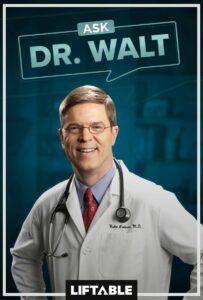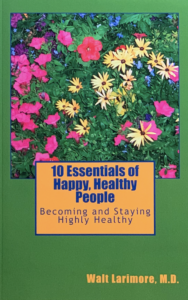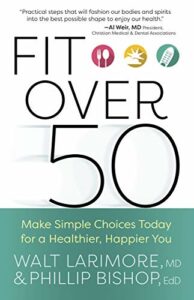Ask Dr. Walt – Episode #2 – The ABCDEs of heart health OR How to have a healthy heart

The Writer’s Studio 02 – My Interview with Mega-Best-Selling Author: Jerry B. Jenkins (Part 2 of 2)
April 21, 2023
A really sweet review of my WWII book
April 26, 2023I’ll share the five factors, the ABCDEs (or the five numbers), you need to know to have a healthy heart. You can click below to watch a video of the show, or I’ve put the show transcript below if you’d prefer that.
From 2021-2022, I was honored to host a TV show on LiftableTV, “Ask Dr. Walt.” Today, I’m releasing Episode #2, HOW TO HAVE A HEALTHY HEART. I hope you’ll enjoy it.
You can learn more about this topic in my best-selling book, 10 Essentials of Happy, Healthy People: Becoming and staying highly healthy or Fit over 50: Make Simple Choices for a Healthier, Happier You.
CLICK HERE FOR 10 E’S CLICK HERE FOR Fo50
Disclaimer: The “Ask Dr. Walt” show is designed for entertainment purposes to give information on various medical conditions, treatments, and procedures for your personal knowledge and to help you be a more informed consumer of medical and health services.
SHOW TRANSCRIPT
How to Have a Healthy Heart — Five Numbers You Need to Know
TEASE:
Five numbers you need to know to dramatically reduce your risk of premature death. Who wouldn’t want to know this? Celine Dion sang the theme song for the movie, “Titanic,” and claimed, “My heart goes on and on.” Today, I’m going to show you how you can help your heart go on and on.
OPEN:
Hi, everyone. I’m family physician Dr. Walt Larimore and I’m delighted you are taking the time today to join me in my office to chat about your heart health.
The main function of your heart is to keep blood that’s full of oxygen circulating throughout your body. Because your heart is crucial to your survival, it’s important to keep it healthy with a well-balanced diet and exercise, and avoid things that can damage it, like smoking, stress, worry, anxiety, and poor nutrition.
Here are some fun facts about the heart that you may not know.
| 1. The average heart is the size of a fist in an adult and will beat about 115,000 times each day.
2. Your heart pumps about 2,000 gallons of blood every day. 3. If you were to stretch out your blood vessel system, it would extend over 60,000 miles. 4. The first open-heart surgery occurred in 1893. It was performed by Daniel Hale Williams, who was one of the few African American cardiologists in the United States at the time. 5. The first implantable pacemaker was used in 1958. Arne Larsson, who received the pacemaker, lived longer than the surgeon who implanted it. |
| 6. The youngest person to receive heart surgery was only a minute old. She had a heart defect that many babies don’t survive. Her surgery was successful.
7. The earliest known case of heart disease was identified in the remains of a 3,500-year-old Egyptian mummy. 8. Most heart attacks happen on a Monday and Christmas Day is the most common day of the year for heart attacks occur. 9. It’s possible to have a broken heart. It’s called broken heart syndrome and can have similar symptoms as a heart attack. 10. Laughing is good for your heart. It reduces stress and gives a boost to your immune system. |
But heart disease is no joke. According to the CDC:
| 1. Heart disease is the leading cause of death for men, women, and people of most racial and ethnic groups in the United States.
2. One person dies every 36 seconds in the United States from cardiovascular disease. Centers for Disease Control and Prevention |
| 3. About 655,000 Americans die from heart disease each year—that’s 1 in every 4 deaths.
4. Although heart disease is sometimes thought of as a man’s disease, almost as many women as men die each year of heart disease in the United States. Centers for Disease Control and Prevention |
| 5. Heart disease is a killer that strikes more women than men and is more deadly than all forms of cancer combined.
6. While one in 31 American women die from breast cancer each year, heart disease is the cause of one out of every three deaths in women. Centers for Disease Control and Prevention |
What puts you at most risk for heart and cardiovascular disease? Of course, high blood pressure, high blood cholesterol, and smoking are key risk factors for heart disease.
| Key Risk Factors for Cardiovascular Disease
1. Smoking 2. High Blood Pressure 3. High Cholesterol American Heart Association |
But there are several other medical conditions and lifestyle choices that can also put you at a higher risk for heart disease, including:
| Other Major Risk Factors for Cardiovascular Disease 1. Diabetes2. Overweight and obesity 3. Unhealthy diet 4. Physical inactivity 5. Excessive alcohol use American Heart Association |
When it comes to your car, every one of you know that preventive checkups – checking and changing the oil, checking tire pressure and the depth of your tire tread, keeping your wheels balanced, checking and maintaining vital fluid levels – all of these checks allow your vehicle to run smoother, last longer, travel safer, and can save a lot of trouble and money. The same is true for your body.
Today I want to tell you about the five checkups, the five numbers, or the five letters that you need to know to keep your heart from blowing out or burning out or becoming flat.
According to a study published in the Journal of the American Heart Association:
| · The number of people with an ideal cardiovascular health score, based on seven lifestyle and biological measures, decreased from 8.5 to 5.9 percent over the last 20 years.
· Researchers said the decrease was due to poorer scores for blood pressure, blood cholesterol, blood sugar (also called blood glucose), and BMI. Journal of the American Heart Association |
In other words, 94 percent of you need to find out your numbers and the sooner the better!
The five factors, the ABCDEs, you need to know are:
| A. A1C
B. BMI C. Cholesterol D. Diastolic and systolic blood pressure E. Estimated cardiac risk |
Let’s take a very brief look at each one:
| A. The “A” of the “ABCDEs” is “A1C” |
Think ABC but substitute a “1” for the “B” and you get “A1C” instead of “ABC.” The A1C is a blood test that is also called the glycated hemoglobin. It can estimate your risk of prediabetes or diabetes by telling you your average blood sugar level for the previous two to three months.
A high blood sugar, also called a high blood glucose, could mean you have or are heading toward diabetes. Untreated diabetes leads to many serious medical problems including heart disease, stroke, and premature death. The Harvard School of Public Health says that of the leading risk factors for premature death high blood sugar is number five, killing 190,000 Americans a year:
| Leading preventable risk factors for premature death in the US. 1. Smoking: 467,000 deaths each year2. High blood pressure: 395,000 3. Overweight/obesity: 216,000 4. Sedentary behavior (inactivity or inadequate physical activity): 191,000 5. High blood sugar: 190,000 6. High LDL (bad) cholesterol: 113,000 Harvard School of Public Health |
The American Diabetes Association recommends regular screening for diabetes starting at age 45, with repeated tests at least every three years. However, I agree with the recommendation of the U.S. Preventive Services Task Force that recommends starting at age 35. The main reason is the epidemic of overweight and obesity that is leading to more diabetes.
| Diabetes Screening · Starting at age 35, with repeated tests at least every three years.U.S. Preventive Services Task Force · Starting at age 45, with repeated tests at least every three years. · For all adults who are overweight or obese AND have at least ONE cardiovascular risk factor such as high blood pressure, high cholesterol, physical inactivity, or smoking. · For all children and adolescents who are overweight or obese AND have at least TWO cardiovascular risk factors. American Diabetes Association |
If you’re under age 35, but are overweight or obese, and have at least one additional cardiovascular risk factor such as smoking, high cholesterol, physical inactivity, or high blood pressure, you should also talk to your family doctor about A1C screening at least every three years.
Some doctors will do a fingerstick or blood sugar or glucose test – either random or fasting – but these only tell you your blood sugar at one instant in time. The A1C will tell you your average for the last two or three months.
| B. The “B” of the “ABCDEs” is “BMI” |
BMI, or body mass index, is based upon a calculation that takes into account your height and weight. There are many of BMI calculators on the Internet and your BMI will show that you’re either normal, overweight, extremely overweight, obese, or morbidly obese.
In America, about one-third of adults are obese and over 70 percent are overweight or obese. And unfortunately, our children are following in our footsteps.
The Harvard School of Public Health says that of the leading risk factors for premature death overweight/obesity is number three, killing 216,000 Americans each year.
| Leading preventable risk factors for premature death in the US.
1. Smoking: 467,000 deaths each year 2. High blood pressure: 395,000 3. Overweight/obesity: 216,000 4. Sedentary behavior (inactivity or inadequate physical activity): 191,000 5. High blood sugar: 190,000 6. High LDL (bad) cholesterol: 113,000 Harvard School of Public Health |
| C. The “C” of the “ABCDEs” is “cholesterol” |
Cholesterol is a waxy substance your body uses to protect nerves, make cells, and produce certain hormones. Your liver makes all the cholesterol your body needs. Your body also gets cholesterol directly from foods such as eggs, meats, and dairy products.
Now, there are good and bad forms of cholesterol.
| LDL
· low-density lipoprotein · “bad” cholesterol delivers cholesterol to the body and into the walls of your arteries where it can build up and do damage · the HIGHER the number the HIGHER your risk · “LDL = “lethal” cholesterol HDL · high-density lipoprotein · “good” cholesterol because it removes cholesterol from the bloodstream. · the HIGHER the number the LOWER your risk · “HDL” = “healthy” cholesterol |
If your total cholesterol level is high because of a high LDL, you are at higher risk of heart disease, heart attack, high blood pressure, or stroke. But, if your total cholesterol level is high only because of a high HDL, you’re actually at a lower risk for these problems.
So, you want your HDL to be high and your LDL to be low.
The blood test to test your total cholesterol, HDL cholesterol, and LDL cholesterol, and another bad blood fat called, “triglycerides,” is called a lipoprotein profile.
| The Traditional Lipoprotein Blood Profile will include at least: · Total Cholesterol |
· LDL Cholesterol
· HDL Cholesterol
· Triglycerides
The American Heart Association recommends a lipoprotein profile be taken every four to six years, starting at age 20. The U.S. Preventive Services Task Force recommends lipid testing men starting at 35 years and women starting at 45 years if they have no cardiovascular risk. And they recommend testing for all adults with any cardiovascular risk starting at age 20.
Since most people have a cardiovascular risk such as overweight, obesity, a sedentary lifestyle, or smoking, I recommend starting lipoprotein testing at age 20 and checking it no less than every five years. And you may need to be tested more frequently if your family physician determines that you’re at an increased risk for heart disease or stroke.
| Cholesterol Screening
· Starting at age 20, a lipoprotein profile every four to six years. American Heart Association · Starting at age 20 for men and women at increased risk for cardiovascular disease and then every five years. · Starting at age 35 for men and 45 years of age for women and then every five years. U.S. Preventive Services Task Force |
| D. The “D” of the “ABCDEs” is “diastolic and systolic blood pressure” |
The American Heart Association recommends that all adults 20 or older get their blood pressure checked at least once every two years as long as it is below 120 over 80. The U.S. Preventive Services Task Force recommends starting at 18 years of age, which is what I recommend also.
| High Blood Pressure Screening · Starting at age 20, all adults should have their blood pressure checked once every two years if it is below 120/80. |
American Heart Association
The upper number is called the systolic blood pressure and the lower number is called the diastolic blood pressure. If your systolic blood pressure is 120 or above or your diastolic blood pressure is 80 or above, you should have your blood pressure taken more often.
This is so important as the Harvard School of Public Health lists high blood pressure as the number two cause of preventable premature death – only following smoking – killing about 395,000 Americans each year.
| Leading preventable risk factors for premature death in the US. 1. Smoking: 467,000 deaths each year |
2. High blood pressure: 395,000
3. Overweight/obesity: 216,000
4. Sedentary behavior (inactivity or inadequate physical activity): 191,000
5. High blood sugar: 190,000
6. High LDL (bad) cholesterol: 113,000
Harvard School of Public Health
By the way, almost all experts recommend that abnormal blood pressure readings be confirmed by obtaining blood pressure readings away from the doctor’s office—for example, with home blood pressure monitoring—before starting treatment. This is a key recommendation because merely being in medical facilities raises some people’s blood pressure.
Now, these ABCDs make up what the U.S. Preventive Services Task Force, an independent panel of experts in primary care and prevention, and the American Heart Association, along with other national groups, are calling “The Four Numbers You Need to Know.”
They lump these four together because they are part of a common and dangerous disorder called “metabolic syndrome,” which is a set of risk factors for heart disease and premature death—including high blood sugar (our A), overweight (our B), high cholesterol (our C) and high blood pressure (our D). What makes it so evil and insidious is that metabolic syndrome typically does not have any recognizable signs or symptoms until it’s too late.
| Metabolic syndrome includes: · high blood pressure, |
· high blood sugar,
· excess body fat around the waist, and
· abnormal cholesterol levels.
Metabolic Syndrome increases a person’s risk for heart attack and stroke.
Aside from a large waist circumference, most of the disorders associated with metabolic syndrome have no symptoms.
Mayo Clinic
The Number of Americans Being Damaged by NOT knowing or treating their ABCDs is staggering.
The CDC reports 39 million adults aren’t taking the recommended statin drug to manage their cholesterol, 40 million Americans are living with uncontrolled high blood pressure, more than 100 million have poor blood sugar control and likely have diabetes or prediabetes, and more than about 170 million are overweight or obese.
| The Number of Americans Being Damaged by NOT knowing or treating their ABCDs
· 39 million adults aren’t taking the recommended statin drug to manage their cholesterol, · 40 million Americans have unrecognized or uncontrolled high blood pressure:, · Over 100 million have poor blood sugar control and likely have diabetes or prediabetes, and · Over 170 million are overweight or obese. Center for Disease Control and Prevention |
The Percent of Americans Who Have NOT Been Screened for the ABCDs is amazing. For example, 13 percent of U.S. adults over 35 years old have not had blood pressure screening, 18 percent have not had cholesterol or lipid screening, and 36 percent have not had diabetes or obesity screening.
| The Percent of Americans Who Have NOT Been Screened for the ABCDs
· No blood pressure screening: 13 percent · No cholesterol screening: 18 percent · No diabetes screening: 36 percent · No obesity screening: 36 percent Center for Disease Control and Prevention |
Although most people know that at least some of these factors can increase their risk for disease and premature death—from cardiovascular disease, diabetes, cancer, and other health problems, most don’t know how they are linked together and how often they should be evaluated for each.
But now you do. And I hope you’ll get yourself, your family, and your loved ones screened. And you could consider working with health professionals in your community to set up a once or twice a year health fair at your church or faith community.
| E. The “E” of the “ABCDEs” is “evaluate your 10-year cardiac risk.” |
Before we finish, and based upon national guidelines, I want to add a fifth risk factor, the “E” of our “ABDCEs” which is to evaluate your 10-year cardiovascular risk.
The U.S. Preventive Services Task Force now recommends a calculation of your 10-year cardiovascular disease risk in all adults aged 40 to 75 years. Several cardiovascular risk calculators are available on the Internet. The most used one is the Framingham Risk Score. It estimates your individual risk of developing potentially deadly coronary heart disease in the next 10 years.
So, let’s sum up:
At age 18 to 20 years of age begin blood pressure testing and your BMI calculation at least every 2 years and lipid testing at least every five years.
Include an A1C blood sugar test every five years if you’re overweight and have an additional risk factor such as smoking or high blood pressure.
If you’re normal weight, at age 35 add A1C testing every 3-5 years.
And at age 40 add cardiac risk scoring.
| Dr. Walt’s ABCDE Screening Recommendations · 18-20 years of age: blood pressure testing and BMI calculation at least every 2 years. |
· 20 years of age: lipid profile testing at least every five years.
· 20 years of age: blood sugar testing with an A1C every three to five years if you’re overweight and have an additional risk factor such as smoking, high blood pressure, or sedentary activity.
· 35 years of age: blood sugar testing with an A1C every three to five years if you’re normal weight, at age 35 add A1C testing every 3-5 years.
· 40 years of age: cardiac risk scoring.
So, a quick review. Not one of you wants to die prematurely, right? But 94 percent of you are at a high risk to do so because you don’t know your ABCDEs.
Do you remember them? The five factors, the ABCDEs, you need to know? They are:
- A1C
- BMI
- Cholesterol
- Diastolic and systolic blood pressure
- Estimated cardiac risk
| The ABCDEs You Need to Know A. A1C |
B. BMI
C. Cholesterol
D. Diastolic and systolic blood pressure
E. Estimated cardiac risk
If all are normal, your health vehicle passes inspection and is ready to continue on a smooth journey down the road of life. If one or more of these factors are abnormal, you’re due for a tune up. And that’s exactly what we’re going to talk about in future editions of “Ask Dr. Walt.”
Well, we need to close our time. I hope you’ll drop in next week. I’ll be telling you the keys to boosting and maintaining your immune system to help it fight off colds, influenza, and maybe even the Corona viruses.
If you’re interested in reading more about today’s program, there are two of my books you might want to consider picking up at my website, www.DrWalt.com.
- Fit over 50: Make Simple Choices for a Healthier, Happier You, or
- 10 Essentials of Happy, Healthy People: Becoming and staying highly healthy
But until next week, to quote the Apostle John, “Dear friend, I pray that you may enjoy good health and that all may go well with you, even as your soul is getting along well.”
You can learn more about this topic in my best-selling book, 10 Essentials of Happy, Healthy People: Becoming and staying highly healthy or Fit over 50: Make Simple Choices for a Healthier, Happier You.
CLICK HERE FOR 10 E’S CLICK HERE FOR Fo50
Disclaimer: The “Ask Dr. Walt” show is designed for entertainment purposes to give information on various medical conditions, treatments, and procedures for your personal knowledge and to help you be a more informed consumer of medical and health services.
© Copyright WLL, INC. 2023. This blog provides healthcare tips and advice that you can trust about a wide variety of general health information only and is not intended to be a substitute for professional medical advice, diagnosis, or treatment from your regular physician. If you are concerned about your health, take what you learn from this blog and meet with your personal doctor to discuss your concerns.








